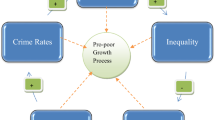Abstract
This paper studies how income tax rates are determined and how they are related to government corruption in the form of fund capture. A model is presented where rich voters can block redistribution by buying the votes of some poor voters. In equilibrium there is only limited redistribution and income tax rates are a negative function of government corruption. When rich voters can bribe the government, an additional equilibrium with zero taxation is possible. The link between corruption and tax rates is tested using cross country data; the empirical evidence is fully consistent with the predictions of the model.
Similar content being viewed by others
References
Acemoglu, D., Ticchi, D., & Vindigni, A. (2007). Emergence and persistence of inefficient states. NBER Working Paper no. 12748.
Alesina, A., & Angeletos, G. (2005). Fairness and redistribution. American Economic Review, 95, 960–980.
Alesina, A., & La Ferrara, E. (2005). Preferences for redistribution in the land of opportunities. Journal of Public Economics, 89, 897–931.
Atkinson, A. B. (2004). Income tax and top incomes over the twentieth century. Hacienda Pública Española, 168, 123–141.
Baland, J.-M., & Robinson, J. (2008). Land and power: theory and evidence from Chile. American Economic Review, 98, 1737–1765.
Barro, J. (1973). The control of politicians: an economic model. Public Choice, 14, 19–42.
Benabou, R., & Ok, E. A. (2001). Social mobility and the demand for redistribution: the POUM hypothesis. The Quarterly Journal of Economics, 116, 447–487.
Besley, T., & Coate, S. (2001). Lobbying and welfare in a representative democracy. Review of Economic Studies, 68, 67–82.
Bockstette, V., Chanda, A., & Putterman, L. (2002). States and markets: the advantage of an early start. Journal of Economic Growth, 7, 347–369.
Breyer, F., & Ursprung, H. (1998). Are the rich too rich to be expropriated? Economic power and the feasibility of constitutional limits to redistribution. Public Choice, 97, 135–156.
Brennan, G., & Buchanan, J. (1980). The power to tax: analytical foundations of a fiscal constitution. Cambridge: Cambridge University Press.
Buchanan, J., & Lee, D. (1986). Vote buying in a stylized setting. Public Choice, 49, 3–15.
Buchanan, J., & Tullock, G. (1962). The calculus of consent: logical foundations of constitutional democracy. Ann Arbor: University of Michigan Press.
Docquier, F., & Tarbalouti, E. (2001). Bribing votes: a new explanation to the ‘inequality-redistribution’ puzzle in LDC’s. Public Choice, 108, 259–272.
Easterly, W., & Levine, R. (2003). Tropics, germs, and crops: how endowments influence economic development. Journal of Monetary Economics, 50, 3–39.
Easterly, W., & Rebelo, S. (1993). Fiscal policy and economic growth: an empirical investigation. Journal of Monetary Economics, 32, 417–458.
Fernandez, R., & Levy, G. (2008). Diversity and redistribution. Journal of Public Economics, 92, 925–943.
Friedman, E., Johnson, S., Kaufmann, D., & Zoido-Lobaton, P. (2000). Dodging the grabbing hand: the determinants of unofficial activity in 69 countries. Journal of Public Economics, 76, 459–493.
Grossman, G., & Helpman, E. (1996). Electoral competition and special interest politics. Review of Economic Studies, 63, 265–286.
Gwartney, J., & Lawson, R. (2005). In Economic freedom of the world: 2005 annual report. Vancouver: The Fraser Institute.
Hall, R., & Jones, C. (1999). Why do some countries produce so much more output per worker than others? The Quarterly Journal of Economics, 114, 83–116.
Hasen, R. (2000). Vote buying. California Law Review, 88, 1323–1371.
Harms, P., & Zink, S. (2003). Eating the rich vs. feeding the poor: borrowing constraints and the reluctance to redistribute. Public Choice, 116, 351–366.
Kaufmann, D., Kraay, A., & Mastruzzi, M. (2005). Governance matters IV: governance indicators for 1996–2004. World Bank.
La Porta, R., Lopez-de-Silanes, F., Shleifer, A., & Vishny, R. W. (1999). The quality of government. The Journal of Law, Economics, and Organization, 15, 222–279.
Levy, G. (2005). The politics of public provision of education. The Quarterly Journal of Economics, 120, 1507–1534.
Lindbeck, A., & Weibull, J. (1987). Balanced-budget redistribution as the outcome of political competition. Public Choice, 52, 273–297.
Mauro, P. (1995). Corruption and growth. The Quarterly Journal of Economics, 110, 681–712.
Meltzer, A. H., & Richard, S. (1981). A rational theory of the size of government. Journal of Political Economy, 89, 914–927.
Merrifield, J. (2000). State government expenditure determinants and tax revenue determinants revisited. Public Choice, 102, 25–50.
Olken, B. A. (2006). Corruption and the costs of redistribution: micro evidence from Indonesia. Journal of Public Economics, 90, 853–870.
Pande, R., & Udry, C. (2005). Institutions and development: a view from below. Yale University Working Paper.
Persson, T., & Tabellini, G. (1999). The size and scope of government: comparative politics with rational politicians. 1998 Alfred Marshall Lecture. European Economic Review, 43, 699–735.
Piketty, T. (1995). Social mobility and redistributive politics. The Quarterly Journal of Economics, 110, 551–584.
Piketty, T. (2003). Income inequality in France, 1901–1998. Journal of Political Economy, 111, 1004–1042.
Piketty, T., & Qian, Q. (2009). Income inequality and progressive income taxation in China and India, 1986–2015. American Economic Journal: Applied Economics, 1, 53–63.
Piketty, T., & Saez, E. (2006). The evolution of top incomes: a historical and international perspective. American Economic Review, 96, 200–205.
Ravallion, M., & Lokshin, M. (2000). Who wants to redistribute?: The tunnel effect in 1990s Russia. Journal of Public Economics, 76, 87–104.
Roberts, K. (1977). Voting over income tax schedules. Journal of Public Economics, 8, 329–340.
Romer, T. (1975). Individual welfare, majority voting and the properties of a linear income tax. Journal of Public Economics, 7, 163–168.
Sanyal, A., Gang, I., & Goswami, O. (2000). Corruption, tax evasion and the Laffer curve. Public Choice, 105, 61–78.
Svensson, J. (2005). Eight questions about corruption. Journal of Economic Perspectives, 19, 19–42.
Traxler, C. (2009). Voting over taxes; the case of tax evasion. Public Choice, 140, 43–58.
World Economic Forum (2004). The global competitiveness report 2004–2005.
Author information
Authors and Affiliations
Corresponding author
Rights and permissions
About this article
Cite this article
Balafoutas, L. How much income redistribution? An explanation based on vote-buying and corruption. Public Choice 146, 185–203 (2011). https://doi.org/10.1007/s11127-009-9589-6
Received:
Accepted:
Published:
Issue Date:
DOI: https://doi.org/10.1007/s11127-009-9589-6




